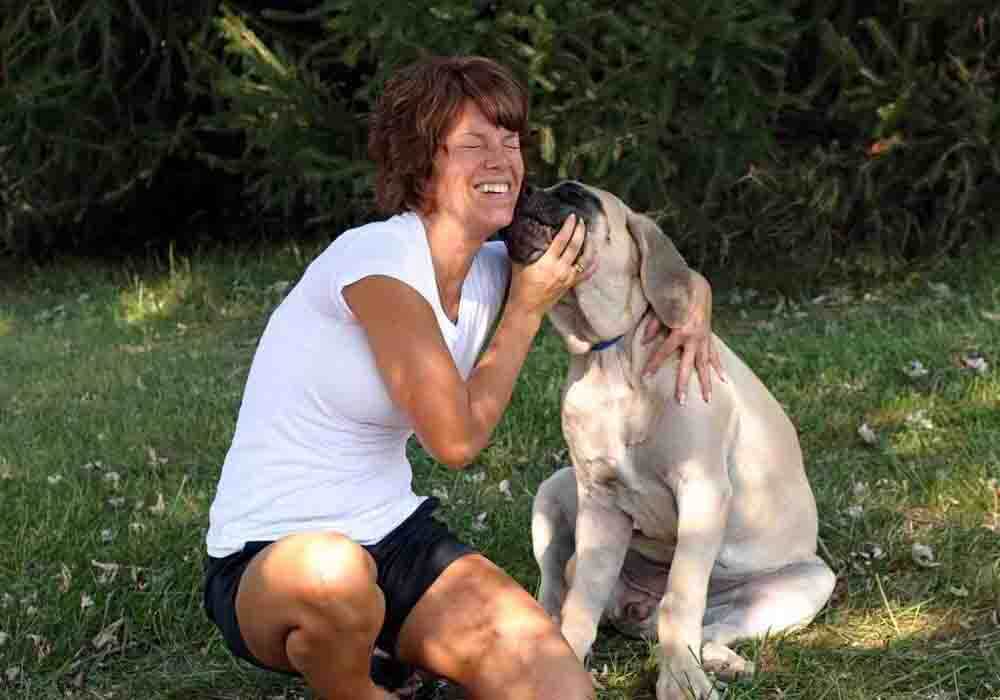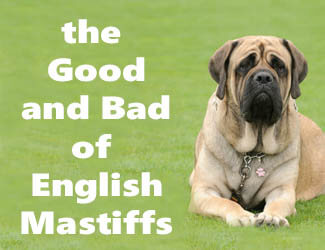How To Care For An English Mastiff
From Puppy To Adult
This Helpful Guide And Tips Cover It All
by Ken Alden
The English Mastiff, or Old English Mastiff, is one of the most lovable dog breeds. Like an oversized armchair, these dogs are comfortable and perfect to nap with. Caring for an English Mastiff is easy, as long as you know what to do.
How To Care For An English Mastiff includes…
- Feed your puppy a diet high in protein of about 25-27%
- Watch for needed vaccinations starting at 6-8 weeks
- Start socialization by meeting new people, children and other dogs
- Be mindful that Mastiffs need exercise but not too much
- Be watchful of health issues that large breeds have
- Know which supplements will benefit your dog the most
In this article, we are going to discuss proper mastiff care. We'll break it down into puppy and adult stages and talk about their eating and exercise habits for each. We'll also look at the things you'll need to raise a happy and healthy puppy and how to set yourself up for success for the length of your dog's life. Read More Below...
Click here to skip down this page to Adult Mastiff Care
Pro-tip: Ever try lifting an English Mastiff? Their weight can hurt not only your back but their joints when they hop down from cars, sofas or even your bed. To protect your back and theirs check out the best Mastiff ramps on Amazon.com now.

- Caring for an English Mastiff Puppy -
If you're a first-time dog owner, an English Mastiff is not a bad choice. They aren't an overly complicated dog, but they do have some quirks that might not be ideal for a first-timer. Let's explore the first of these: feeding.
Feeding an English Mastiff Puppy
English Mastiff puppies are adorable (what puppy isn't), but
these little guys need to follow a specific diet. Because they are a giant
breed, one of the
world's largest, they need a specific
ratio of nutrients in their food to encourage the proper rate of growth. About
half of the calories that puppies eat are used to grow tissue and bone.
Mastiffs need more calories, as they will be so big, but not so many that their
bodies grow too fast.
English Mastiff Puppy Food Requirements
There are three main components of nutrition in dog food: protein, fat, and carbs. Giant dog breeds need a ratio that encourages a proper rate of growth. Some diets cause dogs to grow very quickly, making for a less dense skeleton and causing weak joints. This exponential growth can also cause developmental orthopedic disease (DOD), hip dysplasia, and osteochondritis dissecans (OCD), which are already common in large dogs.
For Mastiff puppies, you should aim for a ratio of 25-27% protein and 12-15% fat. There is no real recommendation for the number of carbohydrates, but you should avoid excessive amounts of wheat and grains. Especially avoid soybean meal, as it can potentially cause bloat.
Your dog will benefit greatly from a high-protein diet. As a guideline, make sure the first three to five ingredients in your pup's food are meat-based.
Here is a general guideline for the amounts of food they'll need
as a growing dog:
Age
4-8 weeks
18-12 weeks
12-16 weeks
4-6 months
6-18 months
Amount per Day
3-4 cups
4-6 cups
5-7 cups
6-8 cups
8-12 cups
Meals per Day
3-4
3-4
3-4
2-3
2
Type of Food
wet/moist
wet/moist
wet/dry
dry
dry
English Mastiff Puppy Feeding Guide…Their First Year
Your English Mastiff will grow quickly, and her food quantities
will get bigger, too. Let's look at the different amounts of food they
should be eating throughout their
first year.
<4 Weeks
As a tiny puppy, your dog will feed from their mother. At first, she won't even be opening her eyes, but your new best friend will be working very hard to grow. Newborn pups feed every two hours for the first seven days, and then the rate slows.
4-8 Weeks
Quite quickly after the dogs open their eyes and start stumbling
around, they'll be able to eat solid food. Solid doesn't mean "hard,"
however. The breeder will soak their kibble in warm water, sometimes mixing in
a tiny bit of greek yogurt for flavor and aid
digestion. Once the food is
softened, the puppies can try and eat it. The dogs will get more and more used
to eating dog food during this month, slowly weaning off their mother's milk.
8-10 Weeks
This is when most Mastiff puppies come home! This is also when your dog will be fully switched to dog food, as her mother most likely won't be coming to your house to feed her anymore. Your breeder will give you the directions on how they have been feeding your dog, and you'll want to follow the same system for a while. Consult with your vet as your puppy goes through her check-ups, keeping your vet up to date on your feeding routine. How to care for an English Mastiff.
At this time, an English Mastiff should be eating four small meals a day, just under half a cup of food at each meal. If your breeder recommends feeding your dog some wet food as well, then you will have to cut the dry food amount down greatly. Wet food has a much higher calorie content than dry dog food.
12 Weeks (3 Months)
By this point, you will have an excellent idea of how your dog eats—whether she is picky or (more likely) happy to wolf down her food. Your Mastiff will probably be very good at convincing you that she is hungry all the time, but you shouldn't feed her more than the recommended amount. Doing so can cause an extreme influx in growth that will damage her frame long-term.
A three-month-old Mastiff should be eating about five cups of food over four meals in the day. Continue to moisten the food for your dog or mix in wet food, as they will still be eating with their milk teeth only, and they can break easily.
16 Weeks (4 Months)
Continue with your routine of four meals a day for another month. You can lower to three meals a day throughout this month if you wish, but four is better. Puppies are active and require a steady stream of nutrients throughout the day, not two big influxes of food in the morning and night.
At this point, your pup will be eating between five to seven cups of softened food a day, depending on their size and gender. After this month, you should stop mixing any wet food into your pet's meals.
20 Weeks (5 Months)
At this point, you can lower your dog's number of meals to three times a day. Your Mastiff will almost have all of its adult teeth in at this point, so you're almost able to switch to totally dry food if you wish. As a segue, you can soak most of your puppy's food and then stir in a small handful of dry kibble right before you feed her. This will get her used to the texture of dry food.
6-8 Months
Over these three months, you can slowly change your dog over to two meals a day. Split the lunchtime meal amount between morning and night, so eventually, her breakfast and dinner are equal. Your dog will likely get up to eight or nine cups of food a day over this time as well, but be sure to consult with your vet as to when to switch her over.
Also, by six months, most dogs have all of
their adult teeth. You can completely
switch your furry friend over to dry food if you wish.
9-12 Months
Now that your dog is used to eating dry food and only twice a day, you can perfect the amount of food that she is eating. If your Mastiff is on the smaller side, they may only need eight cups of food a day, but they could eat up to twelve cups if they are larger. These numbers are always fluctuating as your dog varies between growth stages and energy levels, too.
For instance, a few days of lethargy will require a lower caloric intake, and so you can feed your dog a little bit less. On the contrary, if your Mastiff has a few days of high-activity, you can increase their food quantity a little to compensate.
Over One Year
Because
English Mastiffs are a giant breed, they continue to grow for a very long time.
These dogs actually don't stop growing until they are four years
old. For this reason, you should continue to feed your dog puppy for longer
than smaller dogs, who often switch over at one year.
Pro-tip: English Mastiff anxiety, aggression, destructive chewing, jumping up, fearfulness, and other behaviors can be controlled with the right training program.
Here’s a great course that
addresses these issues along with many other dog training basics: Check it out now!
How Long Should I Feed My English Mastiff Puppy Food?
As noted above, English Mastiffs need to eat puppy food for much longer than smaller breeds. You can comfortably feed your Mastiff puppy food until they are 18 months old. At that point, you'll likely switch your dog over to adult food, but as with all food adjustments, the change should be gradual.
English Mastiff Vaccination Shot Schedule for Puppies
There are a few main vaccinations that are integral to a young dog's health:
- Canine Distemper
- Canine Parainfluenza
- Heartworm
- Rabies
- Bordetella Bronchiseptica
- Leptospirosis
- Lyme Disease
- Canine Hepatitis
- Coronavirus (Different from COVID-19)
- Kennel Cough
- Parvovirus
Some of these vaccines are required in various states, while
others are considered extra. Usually, all puppies follow the same
vaccination schedule as listed by the
American Kennel Club and shown on this page.
Age
6-8 weeks
10-12 weeks
16-18 weeks
12-16 months
Every year
Every 2 years
AKC Recommended Vaccination
Parvovirus, Distemper
Distemper, Hepatitis,
Parainfluenza, and
Parvovirus
Rabies, Distemper,
Hepatitis, Parainfluenza,
and Parvovirus
Rabies, Distemper,
Hepatitis, Parainfluenza,
and Parvovirus
Rabies, Distemper,
Hepatitis, Parainfluenza,
and Parvovirus
Rabies
Extra Vaccination
Bordetella
Influenza, Leptospirosis,
Bordetella, Lyme disease
Influenza, Leptospirosis,
Bordetella, Lyme disease
Coronavirus, Leptospirosis,
Bordetella, Lyme disease
Influenza, Coronavirus,
Leptospirosis, Bordetella,
Lyme
n/a
How Much Exercise Do English Mastiff Puppies Need?
While it's true that English Mastiffs are not a highly active breed, they still need exercise. When your puppy first comes home, you won't be doing much moving at all. A lot of play in the first four months of your dog's life will look like rolling around on the grass, chewing soft toys, and learning your commands.
There is a general rule with puppies that you can walk your
puppy for five minutes for each month of age. You can do this amount twice a
day. For some breeds, like Border Collies, this ratio won't really apply, as they will need more exercise
than that. However, this rule of thumb is perfect for Mastiffs and can be seen
as follows:
Age
2 months
3 months
4 months
5 months
6 months
Walk Time
10 minutes
15 minutes
20 minutes
25 minutes
30 minutes
Total Activity Time
per Day
20 minutes
30 minutes
40 minutes
50 minutes
1 hour
Of course, your puppy's exercise won't always be a walk around the neighborhood. Playing with children and other dogs will also count as exercise. The best way to make sure your English Mastiff grows up without injuring is to ensure that they don't take part in any play more exertive than that of playing with other puppies their age, and for the time recommended on the chart above. How to care for an English Mastiff.
To read up more on their exercise requirements visit here.
Things to Not Let Your English Mastiff Puppy Do
Since an injury on a young English Mastiff can lead to such terrible injuries later in life, there are certain activities you should let your puppy do. Avoiding these activities will reduce the risk of joint or bone damage:
- Jump in or out of cars
- Jump on or off furniture
- Use more than 2-3 stairs at a time
- Go on steep or long hikes
- Play with much bigger dogs
- Exercise for too long
- Play catch or fetch for extended periods of time
How to Socialize an English Mastiff Puppy
You've heard of the term "gentle giant," and you've probably heard of it concerning English Mastiffs. While this is generally a very accurate nickname, sometimes, it's not. After all, these dogs were bred to protect, and some have been known to have a mean streak.
The best thing in the world you can do for your puppy to make sure that they become that lumbering friend is to socialize them when they are young. Young dogs need to meet dozens, if not hundreds, of other dogs and people in the first 6 months of their life. The more people that your dog meets, the nicer it will be as an adult. The same goes for other dogs. By following the instructions below, you'll give your pet the best chance at a long and peaceful life. How to care for an English Mastiff.
Meet 10 New People Everyday
If you can get your pup to meet 10 new people every day for the first three months that they are home, you will have a huge jump start on your dog's socialization. It may sound like a lot, but think of how often you see an adorable puppy and want to pet it. Simply walk down a busy street with your baby Mastiff, and the people will come to you.
Meet 100 Dogs in the First 6 Months
Another good number to try and hit is meeting 100 dogs in the first 6 months. Again, this sounds like a huge number, but it's really only two dogs a day! Give your dog time to properly meet, greet, and get to know these dogs, and she'll grow up to be comfortable around all types of canines.
Meet As Many Children as Possible
It's likely that if you're getting an English Mastiff, you have children. This is because they make such excellent family dogs when they are properly socialized. A fully grown Mastiff who doesn't like children is not a safe animal to have in most areas of the world, so even if you don't have kids, your pup needs to meet as many of them as possible.
Always have a good hold on your dog when they first meet children. Chances are, your Mastiff will inherently love kids, but even a nice dog can knock a child over accidentally.
Take Your Dog to Various Places
Socializing your four-legged friend isn't just about meeting people and dogs; it's also about meeting the world. To socialize your English Mastiff puppy, you should take them to many different places. Sit with them and walk with them through these locations until they are comfortable everywhere:
- Cafes
- Restaurants
- Parks
- Malls
- Schools
- Playgrounds
- Beaches
- Pet Stores
- Construction Areas
- Near Railways
- Downtown Streets
- Dog parks
Throw Your Dog a Puppy Party
A fantastic way to socialize your puppy and yourself is to throw your dog a puppy party. Invite as many of your friends over as possible, and ask them to come to meet your new dog. Not only will this help make your quota of human meetings for the day, but it will also get your dog used to the loud noises of a party.
Carry Treats for Strangers to Give Your Dog
Carrying treats for your dog is a good idea for many reasons; you can train your dog everywhere you go, you can distract your dog from something, and you can have something for strangers to give your dog. How to care for an English Mastiff.
By letting a stranger give your dog a treat, you'll help your pup to relate humans to something positive– like freeze-dried chicken.
For more in great socialization tips and ideas visit our page here.
Pro-tip: English Mastiff's (and their owners) love dog crates…and for good reasons. Crates keep dogs from mischief while you're away, are perfect for house training, for traveling by car, and provide the dog a place to de-stress. Check out the best Mastiff crates on Amazon.com now.
English Mastiff Puppy Essentials Your Pal Will Need
No doubt, you're making a list of all of the essentials that you'll need when your puppy comes home. Here is a good baseline to get you started:
- Bed
- Crate
- Dog bowls
- Dog food
- Blanket
- Soft toys
- Treats
- Chewing toys for teething
- Collar
- Leash
- Harness
- Pee pads
- Pet deodorizer
- Nail clippers
- Brush
- Caring for an English Mastiff Adult -
Now that your puppy has grown into a well-socialized, healthy dog, we can discuss the requirements of an adult English Mastiff.
How Big Will My English Mastiff Get?
English Mastiffs keep growing until they are four years old. Their maximum height and weight vary depending on breed and gender. On average, females will roughly be about 150 pounds, while males will be 160 pounds.
English Mastiff Nutritional Requirements
As we've learned, giant breeds have different nutritional requirements from other dogs. Large and giant breeds are more at risk of certain diseases, and their diets should work to minimize these risks. High meat/ protein diets are best for these dogs, while the fat content should be even lower than when they were puppies.
Aim for protein content of at least
18%, and keep the fat content below 15%.
How Much Should I Feed My English Mastiff?
An adult English Mastiff is one of the biggest eaters when it comes to the dog world. You should be prepared to pay well over $100 per month in food for your dog. However, when it comes to amounts, that depends on what kind of food you are giving your dog.
Dry food is better overall for your Mastiff. It has lower fat content than soft or wet food, and it helps to scrape the tartar from their teeth and gums. Canned food is high in fat and often causes soft stool, which can, in turn, affect the anal glands. As such, you should never feed your dog wet food only. If anything, canned food should be used as an appetizing topper for meals, not as the main event.
The following chart serves as a guideline for feeding your adult English Mastiff:
Dry Food
8-12 cups a day
Dry/ Wet Mixed
4 cups dry, 1-2 cans wet
Wet Food
4-8 cans a day
How Much Exercise Does an English Mastiff Need Everyday?
English
Mastiffs are one of the least active breeds. 20-30 minute walks are plenty for your Mastiff, as long as you go on three per
day. Your dog would also do well to spend most of their time outside, as they
can stretch out and wander at their leisure.
English Mastiff Grooming
While these dogs have a short coat, they do shed constantly. You should be prepared to do daily sweeping or invest in a very good vacuum. To help combat this shedding, you can brush your dog with a firm bristled brush twice a week. Doing this outside will help minimize the mess.
A bi-monthly bath is also a good idea for Mastiffs, though they would likely enjoy the trip to the groomers as well.
Learn more about Mastiff grooming from nose to toes on our page here.
English Mastiff Health Issues and the Best Way to Address Them
There are a few main
health concerns to be aware of when
investing in the English Mastiff breed. Let's review them and the main ways to
fight these conditions.
Canine Heart Disease
Aging, heartworm, and unhealthy weight can all contribute to canine heart disease. Unfortunately, this condition cannot be reversed, but it can be treated. If your dog is diagnosed with heart disease, your vet will likely recommend a low-sodium diet to minimize the organ's swelling.
Bloat
Bloat is one of the most common diseases in large dogs. It involves a twisting of the stomach that cuts off circulation to important organs. This condition requires immediate surgery, but you can help diminish the risk by making sure your dog eats slowly. Slow feeder bowls are an excellent way to pace your pup's meals.
Canine Cancer
It seems extra cruel that pets can get cancer too, but unfortunately, they can. Hard to avoid, you can extend your dog's life by keeping him healthy, active, and on a proper diet. You can also extend your dog's life by neutering or spaying them. These operations greatly reduce the chance of either breast or testicular cancer in your pet.
English Mastiff Supplements
Because English Mastiffs have health issues, there are special supplements that you can add to their diet to help keep them in top shape.
Cosequin Maximum Strength Joint Supplement
Cosequin makes one of the bestselling dog supplements that can greatly benefit your Mastiff. Because all large breeds are at risk of hip dysplasia and arthritis, it's important to take care of their joints. These tasty treats will help with your dog's mobility, joints, and cartilage health. As a bonus, it also contains Omega-3s for her skin, coat, and nails.
Purina Pro Plan FortiFlora Supplements With Probiotics
If you find that your English Mastiff has diarrhea often, these probiotics are an excellent way to help them get back on track. The active probiotics can help regulate your dog's intestinal microflora and allow their systems to extract the nutrients needed from their food.
One of the healthiest toppers for your dog's food is all-natural salmon oil. A few pumps of this liquid onto your Mastiff's dry food, and they'll reap the following benefits:
- Enhanced immune system
- Healthy heart
- Improved hip and joint function
- Eased rashes or hot spots
- Shiner coat
- Stronger nails
- Softer fur
How To Care For An English Mastiff...Final Thoughts
English Mastiffs are one of the world's noblest breeds. They are an excellent family dog, born defenders of their families if you have room for them. If you are about to bring your Mastiff puppy home, make sure to socialize, exercise, and train your dog while they are young and still small enough for you to hold them.
Return to the top of this How To Care For An English Mastiff page

About the Author...
Ken Alden, a dedicated Mastiff owner for over eight years, is acclaimed for his expertise in care, grooming, and training. Read more About Me and my dog Shadow.
- Mastiff Guide Home ›
- English Mastiffs ›
- How To Care For An English Mastiff






